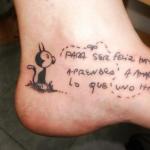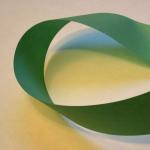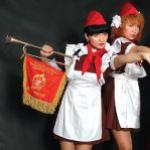Attributes of royal power. Crown Jewels of Great Britain: Little-Known Facts and Unexpected Stories Famous British Crown Stones
In 1649, by order of Oliver Cromwell, all royal treasures, including the coronation regalia, were melted down, symbolizing the overthrow of the monarchy and the establishment of the English Republic (lasted from 1649 to 1660). When the monarchy was restored, it turned out that of all the treasures, only a 13th-century spoon and three swords had survived. Therefore, all coronation regalia had to be created anew.
Nowadays, all coronation regalia and many other jewels of the British crown are exhibited in.
Crowns of England (Great Britain)
(St. Edward's Crown, 1661) - a golden crown used for most coronation ceremonies. Decorated with 444 precious stones. The Crown of St. Edward is very heavy (2.23 kg) and uncomfortable, so Elizabeth II uses a lighter version for ceremonial occasions.
Imperial crown(Imperial State Crown, 1937) - created for King George VI as an exact copy of Queen Victoria's 1838 Crown, which was worn out by that time. The crown is decorated with a huge number precious stones- 2868 diamonds, 273 pearls, 17 sapphires, 11 emeralds and 5 rubies. Among these stones there are many famous ones: for example, the Black Prince ruby and the Cullinan II diamond. The crown is used after the end of the coronation, when the monarch leaves Westminster Abbey, and during the annual opening ceremony of the sessions of Parliament.



(Crown of Queen Elizabeth, 1937) is the only platinum crown in the entire collection. It was created for the wife of King George VI, Elizabeth, who, to distinguish herself from her namesake daughter, bore the title Queen Mother. The crown is set with a 105-carat Kohinoor diamond, as well as many smaller diamonds.
(Imperial Crown of India, 1911) and (Crown of Queen Mary, 1911) - were created on the occasion of the visit to India by George V and his wife Queen Mary. The need for their creation arose because the law prohibited the use of royal regalia outside Britain. Both crowns were used only once. They are not part of the Crown Jewels, but are kept with them in the Tower. At the time of its creation, the Crown of Queen Mary was decorated with such famous diamonds as Kohinoor, Cullinan III and Cullinan IV, but already in 1914 they were replaced with crystal imitations. Today the crown is decorated with 2,200 diamonds.



Scepters
(Sovereign's Sceptre with the Cross, 1661) is used during coronation (the monarch holds it in right hand). In 1910, the Cullinan I Diamond, the largest cut diamond in the world, was set into the scepter.


(Sovereign's Sceptre with the Dove, 1661) - a scepter decorated with the figure of a dove, which in Christianity symbolizes the Holy Spirit. During the coronation ceremony, the monarch holds this scepter in his left hand. At the moment of placing the Crown of St. Edward on his head, the monarch holds both scepters.



(Queen Consort's Scepter with Cross, 1685)


(Queen Consort's Ivory Rod with Dove, 1685) - the only coronation jewel made of ivory;


Queen Mary's scepter with dove(Mary II's Scepter with Dove, 1689).


Powers
(Sovereign's Orb, 1661) - a hollow gold ball decorated with a cross and precious stones. Used in the coronation ceremony. The monarch holds it in his left hand during the procession from.
(Small Orb, 1689) was created for the coronation of William III's wife Mary II.



Coronation swords
(Sword of State, 1698) - the largest sword in the collection (weighs more than 23 kg). It is carried before the monarch during the coronation and during the opening ceremony of parliament. The hilt of the sword is gilded and decorated with diamonds in the shape of a rose and thistle - symbols of England and Scotland.

(Jewelled Sword of Offering, 1820) was created for the coronation of King George IV. This is the only sword that the Archbishop of Canterbury gives directly to the monarch during the coronation (symbolizing that royal power is in the service of the church). The precious sacrificial sword is made of Damascus steel and luxuriously decorated with precious stones. During the solemn procession, it is carried instead of the Great Sword, which is too heavy for this.

Also during the coronation, the Sword of Spiritual Justice, Sword of Temporal Justice and Sword of Mercy are carried before the monarch.
Coronation ring
Coronation ring (Sovereign’s Ring, 1831) - a large sapphire with the cross of St. George, rubies, and diamonds. Symbolizes the “marriage” of the monarch with the country. The coronation ring was created for the coronation of William IV and has since been used for the coronation of all subsequent monarchs (previously each monarch received a new ring). There is also Queen Victoria's Coronation Ring, whose fingers turned out to be too narrow for the Coronation Ring of William IV, so a smaller copy was created. The ring of Queen Adelaide, wife of William IV, also belongs to the British crown jewels.

Ampoule and spoon
(Ampulla, 1661) - a vessel in the shape of an eagle with outstretched wings, used during the coronation ceremony to anoint the monarch. The eagle's body is hollow, the head is unscrewed, and oil (blessed oil) is poured inside. After pronouncing the oath, the monarch strips down to his underwear. The Archbishop of Canterbury drips from the Ampoule onto Coronation spoon(The Coronation Spoon, XII or XIII century) and smears it on the hands, chest and head of the monarch, which symbolizes the descent of divine grace on him. After this, the monarch is presented with the remaining regalia - embroidered in gold imperial robe(Imperial Mantle, 1821) weighing more than 13 kg, Golden bracelets(Armills, 1661), symbolizing honesty and wisdom, and spurs(Spurs, 1820), symbolizing military valor.


The coronation spoon is the oldest piece of royal regalia. It is believed to have been used at the coronation of King John in 1199, or even earlier, at the coronation of his father and elder brother (Henry II and Richard I the Lionheart, respectively). The handle is the oldest part and, according to some sources, was made sixty years earlier than the part with the recess. The handle was once covered with enamel, but over the years it has worn off and only traces of the patterns remain. At its widest part, the handle is decorated with four pearls. The spoon itself is made of silver and plated with gold. It is believed that this was the work of Byzantine craftsmen. The part with the indentation (it is divided in the middle by a partition, since the archbishop dips two fingers into it) is also covered with a very elegant pattern.
An inventory of the royal regalia compiled in 1649 mentions a "silver gilt spoon". It was valued at only sixteen shillings and sold, and the new owner, when Charles II returned to the throne, presented it to the monarch.
- group tour (no more than 15 people) for a first acquaintance with the city and main attractions - 2 hours, 15 pounds
- see the historical core of London and learn about the main stages of its development - 3 hours, 30 pounds
- find out where and how the culture of tea and coffee drinking was born, and plunge into the atmosphere of those glorious times - 3 hours, 30 pounds
The largest diamonds in the coronation regalia
British coronation regalia includes two of the world's largest diamonds. We are talking about “Cullinan I” (530.2 carats) and “Cullinan II” (317.4 carats), which adorn the King’s Scepter with Cross and the Imperial Crown, respectively. Both diamonds were obtained by dissecting the largest diamond in history, called Cullinan, also known as the “Star of Africa”.
The history of diamond is quite remarkable. It was discovered at the beginning of the 20th century in the Transvaal Republic (a British colony in South Africa). The Transvaal government presented the diamond to King Edward VII for his 66th birthday, and to avoid the risk of theft during transportation, the valuable cargo was sent to London by regular mail in the strictest secrecy, and the imitation was transported on a special ship with pomp and security. The weight of the uncut mineral was 3106 carats (621 grams). Many refused to believe that diamonds could be that big.
Cullinan had cracks, so it could not be made into one giant diamond. It was decided to split the diamond along these existing cracks. This is how 9 large fragments appeared, which after cutting turned into 9 large diamonds and 96 small ones. All large diamonds retained the old name, only numbering was added (Cullinan I, Cullinan II, Cullinan III, and so on).
Diamond Kohinoor(or Kohinoor), which means “Mountain of Light” in Persian, is not nearly as large as Cullinan I, but is not inferior to it in glory. It is believed that the diamond is already 5 thousand years old and that it brings misfortune to its owners. Indeed, the history of the diamond is replete with bloody pages: it was the property of many Indian, Afghan and Iranian rulers until it was captured in 1848 by British troops. Initially, Kohinoor had a slight yellowish tint and weighed 186 carats, but after additional cutting it lost 40% of its weight, becoming a diamond clean water. Today it adorns Queen Elizabeth's Crown. Let us clarify that India regularly claims its rights to the diamond, claiming that it illegally fell into the hands of British colonialists.
Ruby of the Black Prince- a 170-carat jewel the size of a chicken egg. The ruby is currently set in the Imperial Crown (above the Cullinan II Diamond). It was first mentioned in the mid-14th century, in the ownership of Abu Said, the Moorish prince of Granada. The prince was killed during peace negotiations by order of the King of Castile, Don Pedro the Cruel. However, the ruby remained in the king's possession for only a few years. His half-brother rebelled against him, and Don Pedro was forced to resort to the military assistance of Edward the Black Prince (1312–1377; son of the reigning King Edward III of England), to whom he gave the jewel as payment for the military assistance provided. Thus, the ruby came to England and received its modern name. It is known that later the ruby of the Black Prince adorned the combat knightly helmets of Henry V and Richard III in the battle of Agincourt (1415) and on Bosworth Field (1485), respectively, and in the middle of the 16th century it was inserted into the royal crown.







A century and a half in the Crown Chamber of St. Vita, the coronation regalia of the Czech Republic is kept under seven locks. Due to wars and struggles for the throne, their location changed, but then they returned to Prague again for the coronation. The last ceremony took place in 1836, when King Ferdinand V and his wife Maria Anna were enthroned.
The coronation regalia of the Czech Republic are: St. Wenceslas crown, mantle, staff and orb. They are kept in a stone safe, sealed with seven locks, hidden in a closet behind a metal door. Next to the cabinet hiding the safe there is a table and seven chairs, which are intended for the “key holders,” who are: the president of the country, the head of the Senate, the prime minister, the archbishop, the chairman of the Chamber of Deputies, the Metropolitan of the Cathedral of St. Vita and the mayor of Prague. An equally important attribute of the coronation is the cross; it is not hidden in a safe, but also belongs to the shrines of the cathedral.
Only in rare cases are regalia put on public display. There is a belief: Czechs live in peace and prosper as long as the crown is kept in its place. Another interesting fact- Treasures can be retrieved using seven keys. If you try to open the safe differently, the security system is triggered.
Symbols of Czech royalty
Crown of St. Wenceslas (Svatováclavská koruna). It is made of gold and decorated with precious stones. In the center of the crown is a sapphire cross representing a crucifixion. Weight 2.5 kg, diameter and height with a cross 19 cm. In 1347, the Roman Emperor Charles IV presented a valuable gift to the main patron of the Czech Republic, St. Wenceslas, this is how the crown got its name. The emperor bequeathed to wear it to all subsequent holders of the throne. There is a legend that anyone who dares to illegally try on the crown will be cursed and die in the near future, for which there is real evidence. Eyewitnesses say that it emits an indescribable, mystical radiance. Unfortunately, upon closer inspection of the crown, there are some polishing marks on the gold and the gemstones adorning it have cracks.
Royal mantle (Korunovační plášť). This is a luxurious cloak with a long train, no sleeves, made of silk fabric, 2x3 m in size, framed with white ermine.

Royal power (Královské jablko). Represents a golden ball. Weight 0.780 kg, diameter 22 cm. The hemispheres are united by a strip strewn with sapphires and pearls. The upper part of the ball displays the plot of David's Anointing to reign and battle with Goliath. On the bottom is an image where the Lord shows Adam and Eve paradise and warns about the tree of knowledge. At the top of the ball there is a cross with the inscription: “Lord, with Your help the king rejoices and rejoices.”

Royal scepter (Královské žezlo). It is made of high quality gold. Length 67 cm, weight 1.013 kg. The scepter has several parts connected by pearl rings. The first is made in the shape of a blossoming flower, consisting of spirals, between which sapphires dominate. The second presents an engraved decor with a motif grapevine and flowers. The very bottom part is covered with multi-colored enamel.

Reliquary of Saint Maura (Relikviář svatého Maura). It resembles a wooden casket, the outside of which is decorated with gilded sculptures, precious stones, filigree and enamel. The figures of saints are embossed across the entire surface. It was made by order of the monastery in Floren (modern Belgium), to store the relics of St. Mavra, hence the name. After the French Revolution, the church was closed, but in 1838 Duke Alfred de Beaufort managed to buy the casket. Having restored it, he took the reliquary to his estate. During World War II, while fleeing the country, the Beaufort family hid the casket under the floor of the chapel, where it was discovered in 1985. After restoration, the casket was put on public display for the first time in 2011.

Cross of Zawisza (Závišův kříž). Made of pure gold, the large, double-sided cross reaches a height of 70 cm. The front part is studded with sapphires and pearls, and in the center there is a fragment of the crucifixion of Christ. The reverse side of multi-colored enamel is decorated with the faces of saints. No one knows how he appeared. There is a version that in 1270, the daughter of the Hungarian king Anna, having fled to the Czech Republic, to the court of her daughter Kunguta, secretly took out the cross. So, it was inherited by Kungute, receiving the name in honor of her second husband - the knight of Zawisza, who donated a gift from his wife to the Vyshebrod Monastery. In 1938, the cross was transported to Prague and hidden in the Cathedral of St. Vita.

Hello dears.
I decided to start a new series of posts. I hope you find it interesting, and I myself will try to do as much as possible more posts on this topic. Personally, this kind of thing has always been interesting to me :-)) If you have read my blog, then you know that I have great love for precious and semiprecious stones and beautiful (sic!) products made from them. And where else to observe beauty, if not in the royal treasuries? :-))
Therefore, let us talk about the main royal regalia. About those without whom it is difficult to imagine this or that royal house. Moreover, honestly, there are not so many of them. That is, there are, of course, plenty of royal decorations themselves, but the main ones (again, I’ll emphasize this term) are not very large :-)
Let's give it a try and see where this topic takes us :-))
And I suggest starting with Sweden. Why exactly from her? Well, why not? :-) 
So, you and I have already talked a little about the current ruling dynasty in the post about residences royal family Sweden (here here:)
The royal regalia of Sweden is kept in the Royal Treasury. Some of them are exhibited in the Skattkammaren or Royal Treasury and can be seen in person.
On this moment no coronation takes place. It was canceled back in 1907. Thus, the last crowned king was Oscar II, and the full procedures took place back in 1873. However, at the moment, the procedures, although simplified, are carried out, and therefore some of the royal regalia are still used to this day. Which, as you understand, have not ceased to be the pride of the entire Swedish people, and not just the dynasty. 
I would classify several items as the main royal regalia of the Kingdom of Sweden.
First of all, this:
- crown of Eric XIV;
- scepter of Eric XIV;
- the power of Eric XIV;
- state sword of Gustav III Vasa;
- royal key of Eric XIV.
It's funny that almost all of them remained from the monarch, who had a deep mental disorder and the country was never called anything other than Eric the Mad. 
Each item has its own deep symbolic meaning.
crown - royal honor and dignity;
the scepter is the earthly power of the king and the God-given duty to judge and rule his people;
power - a symbol of the king appointed by God, as his deputy in the reign of the Christian kingdom; 
sword - the king stands at the head of the country’s defense and uses the sword to protect the good and punish the wicked;
the key opens and closes again what is good, closes the gates of the kingdom against all heretics, enemies and infidels, and opens them to the poor and needy.
In addition to the above, official regalia include the robe, royal banners and anointing horn. I would also include here the silver font, the orb and scepter of Gunilla Belke, the orb and scepter of Maria Eleonora, the key of Ulrika Eleonora and some of the 11 (together with the main crown-12) royal crowns. 
The crown of Eric XIV is the oldest crown in the entire country. It was created to order by Flemish craftsmen under the leadership of Cornelius ver Weyden in 1561. It originally bore the letters "E" and "R", the initials of the Latin form of the royal name "Ericus Rex". But then the letters were replaced and the crown underwent its first reconstruction. 
The second already under the rule of the Bernadottes. The upper part of the crown was redone, diamonds were added and pearls were removed. The last time the crown was restored was in 1970. Weighs 1.7 kilograms (it weighed 1715 grams before restoration in 1970) and is decorated with enamel, rubies, diamonds, etc. There is an assumption that the basis was an older royal crown, which the Flemings improved.
The scepter was created by the master Hans Heiderick in 1561 and is made of gold, enamel and a number of precious stones - including diamonds, rubies and sapphires. 
It was originally topped with a large round sapphire surrounded by two intersecting rows of pearls. This sapphire was lost at the baptism of Gustav IV Adolf and was replaced by the current dark blue enamel ball in 1780. 
Eric's power is a unique thing. Crafted from gold, it is engraved and enameled with a map of the world. A sort of golden globe :-)) At the top of the orb there is a smaller ball in blue enamel and covered with stars, above which there is a small cross formed from a diamond table surrounded by three pearls.
The orb was made by Cornelius Ver Weiden and was probably engraved by Franz Beyer in Antwerp in 1568. The original blue enamel dates from 1751 and replaces the original black enamel which was badly damaged at the coronation of Charles XI.
Diameter 16.5, weight - 670 grams.
The royal sword of Gustav III Vasa was made in Augsburg in 1541 by the German merchant Klaus Heider. 
The blade of the sword is richly decorated with etchings and partially gilded. The motifs of the etchings are decorated with scenes in the stories of Moses and Joseph in the book "Secondly" and "Genesis" of the Old Testament.
An interesting element is the royal key of Eric XIV. In fact, this is the royal regalia of only the Swedes and the Popes :-)) It was made in Stockholm in 1561 by Peter Holtsweiler. The key is made of gilded silver. Dimensions 43 cm in length. Weight 676 grams
Let's remember some other regalia. Gunilla Behlke, born Gunilla Johansdotter, was a strong and powerful lady. The second wife of the Swedish king Johan III and his consort in 1585-1592, she did a lot for Protestantism in the country. The scepter she commissioned was designed in 1585 by Mater Antonius Groth. Very pretty and powerful. It is smaller than Eric's power and a little simpler.
The state of Gunilla Bielke was created in 1585 in Stockholm by master Franz Beyer. It is made of gold and covered with beads. Together with the scepter of Gunilla Bielke, the orb is considered the oldest symbol of queens. 
To be continued...
Have a nice time of day.
During the period from 1649 to 1660, when a republic was proclaimed in England, all the royal regalia and other jewelry were either melted down or stolen. But the republic did not last long, it was again replaced by a monarchy, and the regalia royalty were created anew. Today these magnificent treasures are kept in London, in the famous Tower, and amaze with their splendor.

Crown of St. Edward (1661)

This crown was restored under Charles II. It is used for coronations, which take place in Westminster Cathedral. The crown is very beautiful, but heavy, its weight is more than two kilograms. For this reason, Queen Victoria, the great-grandmother of the current queen, for whom it turned out to be very heavy, ordered the production of a new crown, lighter, with which she was crowned in 1838. However, since 1911, the crown of St. Edward began to be used again in the coronation ceremony.


Crown of the British Empire (1837)

This magnificent crown was made in 1837 for Queen Victoria. But seven years later, one of the court dukes accidentally dropped the crown, severely damaging it. In 1911, an almost identical gold copy was made, and all the precious stones were transferred to it. Subsequently, the new crown was modified several times to make it lighter and more comfortable. Now she weighs 910 grams. This new imperial crown was crowned by George VI in 1937 and Elizabeth II in 1953. However, the crown of St. Edward is still used directly for coronation, and the head of the monarch leaving Westminster Abbey after the coronation is already crowned with the luxurious crown of the British Empire.


And this is what the crown looks like today on its owner’s head

Famous British Crown Stones.
Among the magnificent sparkling gemstones that decorate the crown, there are several truly unique ones.
At the top of the crown, in the Maltese cross, is a luxurious sapphire of St. Edward himself. blue color, which was taken from a ring that previously belonged to him, and in the cross below is the famous bright red ruby of the Black Prince of 170 carats (34 g), whose history is full of murders and bloodshed. And he himself resembles a blood clot.

Under this ruby on the pediment of the crown is set one of the largest diamonds in the world - Cullinan II. Its history is as follows... In 1905, a huge diamond weighing more than 3100 carats was found in a diamond copy of the British colony in South Africa, the value of which is equivalent to the value of 94 tons of gold. The diamond found was given the name Cullinan.

But, unfortunately, cracks were discovered in the diamond. Then it was decided to split it along the existing cracks.
The master cutter, who was tasked with splitting the diamond along its natural cracks, prepared for this important task for several months, because he had to make one very precise blow. But everything worked out, and the diamond split into two halves.

In the end from this huge diamond after cutting, 105 diamonds appeared - two large, seven medium-sized and many small ones. The names of large and medium-sized diamonds were not changed, they were just numbered.

And now the 530-carat Cullinan I diamond adorns the king’s scepter, and the 317-carat Cullinan II diamond adorns the crown of the British Empire.


On the back of the crown is the dazzling Stuart Sapphire, which has had several previous owners. It was originally located under the Black Prince Diamond, but was later moved to the back of the crown to make room for the Cullinan II Diamond.







